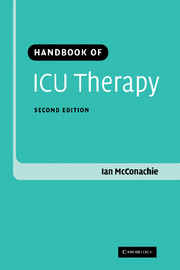Book contents
- Frontmatter
- Contents
- List of contributors
- Preface
- Part I Basic principles
- Part II Specific problems
- 17 The surgical patient in the ICU
- 18 The trauma patient
- 19 Acute coronary syndromes
- 20 Heart failure
- 21 Arrhythmias
- 22 The patient with sepsis
- 23 Acute renal failure in the critically ill
- 24 Acute lung injury and ARDS
- 25 The patient with gastrointestinal problems
- 26 The comatose patient
- 27 The critically ill asthmatic
- 28 The critically ill diabetic
- 29 The cardiac surgical patient in the ICU
- 30 Cardiac arrest
- Index
18 - The trauma patient
Published online by Cambridge University Press: 24 August 2009
- Frontmatter
- Contents
- List of contributors
- Preface
- Part I Basic principles
- Part II Specific problems
- 17 The surgical patient in the ICU
- 18 The trauma patient
- 19 Acute coronary syndromes
- 20 Heart failure
- 21 Arrhythmias
- 22 The patient with sepsis
- 23 Acute renal failure in the critically ill
- 24 Acute lung injury and ARDS
- 25 The patient with gastrointestinal problems
- 26 The comatose patient
- 27 The critically ill asthmatic
- 28 The critically ill diabetic
- 29 The cardiac surgical patient in the ICU
- 30 Cardiac arrest
- Index
Summary
Trauma related deaths typically demonstrate a tri-modal distribution:
Initial mortality, within 30 min of the traumatic event, (e.g. great vessel rupture, gross cerebral disruption) constitutes 50–60% of all trauma-related deaths.
30% constitute deaths within 4 h — usually due to considerable volume loss compounded by ventilatory failure.
The remainder constitute mortality in the days/weeks following the initial event and is typically due to a combination of multi-organ failure and sepsis.
The notion of “The Golden Hour” suggests active resuscitation within the first hour of trauma impacts positively on mortality.
Epidemiology of trauma
In the UK:
Trauma cases occupy 850,000 bed nights (Average hospital stay 10–12 days).
0.5–1.0 major trauma cases/1000 population/year.
75% major trauma cases admitted between 5 p.m. and 8 a.m. (80% <45 years).
Males constitute 72% of trauma related deaths and 56% of non-fatal injuries.
Road traffic accidents (RTA) are a major cause of trauma mortality (in the USA, mortality from RTA accounts for 40% of total trauma mortality).
UK has the highest paediatric RTA rate in the world.
Trauma death rates per million of population/per annum:
UK 88/18,000.
US 111/165,000.
Trauma is the third commonest cause of death in all age groups (UK and US) and the commonest cause of death in <45-year-old age group.
- Type
- Chapter
- Information
- Handbook of ICU Therapy , pp. 248 - 269Publisher: Cambridge University PressPrint publication year: 2006



